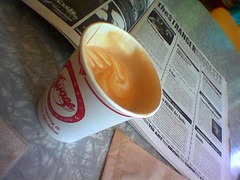
We've been looking at ways to bring a little bit of those conversation-starters into the Starbucks environment.
Terry Davenport, Sr. VP for Marketing at Starbucks commenting on the introduction of the broadsheet Good into Starbucks' locations in this morning's New York Times.
It's implied in the New York Times piece, but not explicitly stated, that the Good broadsheet will be distributed free of charge. "The Good sheet features one advertiser an issue, which covers the cost of the sheet."
I don't have an issue with the distribution of Good in this context -- it looks like a fine publication -- but the piece immediately brought two considerations to mind:
Coffeehouses as we know them in the U.S. are descended from European coffeehouses that took root in the 1600s & 1700s. Historically governments have feared coffeehouses because of the political foment they generate -- whole revolutions have been born in coffeehouses and in the minds of the folks drinking the brew.
This from the New York Review of Books, courtesy of Henry Copley's piece on Blogging from 1750 to 2302 (emphasis my own):
After its creation in Constantinople in 1560, the coffeehouse proliferated in all European cities from the mid-seventeenth century. It first appeared in London in 1660. By 1663, London had 82 coffee houses, by 1734, 551. Because of their free talk and virtuosi, they became known as "tattling universities." They also served as centers for political cabals, for they provided pamphlets and newspapers as well as drink. The first London daily began in 1702 -- long after the first daily newspaper in Germany (Leipzig, 1660) but long before the first in France (Paris, 1777). Print, talk and coffee combined to create a powerful new force everywhere in Europe: public opinion, and public opinion took a radical turn in all the great cities.
Authentic coffeehouses continue to stir up this spirit. They're the last refuge of poets and philosophers, renegades and revolutionaries. The Last Exit in Seattle comes to mind; the Trident in Boulder; Cafe Strada in Berkeley (okay: maybe I'm remembering the Strada's white mocha lattes before white mocha lattes were cool. still. pretty good.).
How far does a coffeehouse have to be neutered past its original inheritance to require the injection of "conversation-starters" into the equation?
Starbucks neglected to share an important part of this story: the fact that some ten years ago now, they made a decision to stop the distribution of free local publications in their retail locations. For me at the time that meant I could no longer pick up my copy of the Stranger or The Seattle Weekly at Starbucks. In Chicago it means you won't find a Chicago Reader.
Might there be a connection between the need to inject "conversation-starters into the Starbucks environment" and the decision, long ago, to distribute only those publications that promised a little coin for the merchant?
Maybe the decision to distribute a free publication now, as the coffee giant struggles to find its coffee-swigging soul, should extend a little bit farther than Good.
p.s. Bonus political coffeehouse content at the midden »






4 comments:
..there is a good chance I visit the Trident this evening :)
"An entertaining magazine about things that matter":
"Stop teaching Catcher in the rye"
thank you keep your good
I have a similar reaction to this... has a bit of a "big brother" feel.
"Here's what you will drink, these are the words you'll use when ordering, here is the music you will listen to, this is what you will read and talk about. Enjoy."
Next thing you will don the "Starbucks kimono" at the door. :-)
what a good coffee house must achieve is a sense of intimacy, locality and place. all the places you describe as the great coffee house do that. they become hubs of community, places to meet and hang out--comfortable, idealogical and unique. if you can sink into a worn chair in a corner and read or talk for an hour or two over a stimulating beverage, that's good living.
starbucks left all that behind when they decided to put a coffee house on every corner, and to print the texture and visual flavor of the place into the faux wallpaper. it is a long way back from where they have ended up.
free local papers would indeed be a good start. as would a return to using local bakers. and real espresso machines. and real sizes like short, medium, tall. since when did coffee start at tall and get bigger?
Post a Comment